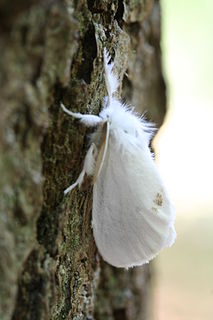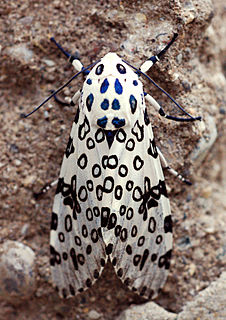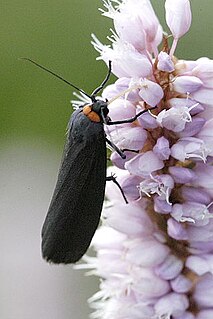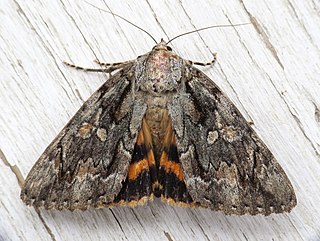
The bordered white or pine looper, is a moth of the family Geometridae. Among these, it belongs to tribe Bupalini of the subfamily Ennominae. B. piniaria is a common species throughout the western Palearctic region, the Near East and North Africa. However, its presence in certain regions – e.g. the northern Balkans – is doubtful.

Laothoe populi, the poplar hawk-moth, is a moth of the family Sphingidae. The species was first described by Carl Linnaeus in his 1758 10th edition of Systema Naturae. It is found throughout the Palearctic region and the Near East and is one of the most common members of the family in the region. It is distinctive due to its habit of resting with its hindwings held further forward than the forewings.

The yellow-tail, goldtail moth or swan moth is a moth of the family Erebidae. The species was first described by Johann Kaspar Füssli in 1775, and has commonly been placed within the related genus Euproctis. It is distributed throughout Europe to the Urals, then east across the Palearctic to Siberia and south to India and Sri Lanka.

The giant leopard moth is a moth of the family Erebidae. They are distributed through North America from southern Ontario, and southern and eastern United States through New England, Mexico and down to Panama. The obsolete name Ecpantheria scribonia is still occasionally encountered.

Eacles imperialis, the imperial moth, is a Nearctic member of the family Saturniidae and subfamily Ceratocampinae. The species was first described by Dru Drury in 1773.
The yellow-cheeked chipmunk, also known as the redwood chipmunk, is a species of rodent in the squirrel family, Sciuridae. It is endemic to areas near the coast of northern California in the United States where it inhabits coastal coniferous forest.

Parascotia fuliginaria, the waved black, is a species of moth of the family Erebidae. It is natively found in Europe as far east as the Ural Mountains, in Armenia and Asia Minor and is an introduced species in North America.

Atolmis rubricollis, the red-necked footman, is a small moth of the family Erebidae. It is found in the summer in forested regions of Europe and Northern Asia. This moth was first described by Carl Linnaeus in his 1758 10th edition of Systema Naturae.

Spilosoma lubricipeda, the white ermine, is a moth of the family Erebidae. It is found throughout the temperate belt of Eurasia from Europe through Kazakhstan and southern Siberia to Amur Region, China, Korea and Japan. In China several sibling species occur.

Platyprepia is a monotypic tiger moth genus in the family Erebidae erected by Harrison Gray Dyar Jr. in 1897. Its only species, Platyprepia virginalis, or Ranchman's tiger moth, was first described by Jean Baptiste Boisduval in 1852. It is found in western North America, ranging from southern Monterrey Bay in California across Nevada and southern Utah to Colorado and north to southern British Columbia. The habitat consists of wet lowland prairies, wet meadows, wet forests and in riparian zones along creeks in dry desert regions.

Cisseps fulvicollis, the yellow-collared scape moth, is a species of the family Erebidae and subfamily Arctiinae. It was described by Jacob Hübner in 1818.

Dicallomera fascelina, the dark tussock, is a moth in the family Erebidae. The species was first described by Carl Linnaeus in his 1758 10th edition of Systema Naturae. It is found in most of Europe, through the Palearctic to Central Asia to Korea.

Setina aurita is a moth of the family Erebidae. It was first described by Eugenius Johann Christoph Esper in 1787.

Catocala neogama, the bride, is an moth in the family Erebidae first described by James Edward Smith in 1797. It is found in North America east of the Rocky Mountains, from Maine and Quebec south to northern Florida and west to South Dakota, New Mexico, and into Arizona and Texas. Its westernmost population from the semiarid Colorado Plateau region is rather distinct and was once considered a separate species, but is now regarded as a well-marked subspecies C. n. euphemia.

Lymire edwardsii, the rubber tree caterpillar or Edwards' wasp moth, is a moth of the subfamily Arctiinae. It was described by Augustus Radcliffe Grote in 1881. It is found in southern Florida, United States.
Pygarctia abdominalis, the yellow-edged pygarctia or orange-bodied pygarctia, is a moth in the family Erebidae. It was described by Augustus Radcliffe Grote in 1871. It is found in the United States from New Jersey south to Florida and west to Texas.
Pygarctia flavidorsalis is a moth in the family Erebidae. It was described by William Barnes and James Halliday McDunnough in 1913. It is found in the US states of Arizona and Texas. There is also a record for Oklahoma.

Pygarctia roseicapitis, the red-headed pygarctia moth, is a moth in the family Erebidae. It was described by Berthold Neumoegen and Harrison Gray Dyar Jr. in 1893. It is found in Mexico and in the United States from southern Arizona to Texas.
Arbelodes flavicolor is a moth in the family Cossidae. It is found in south-eastern South Africa, where it has been recorded from the Impetyeni Forest in the Eastern Cape and KwaZulu-Natal. The habitat consists of mistbelt forests

Leucospermum prostratum is a trailing shrub of up to 4 m (13 ft) in diameter from the Proteaceae. It has alternately set, about 3 cm (1.2 in) long, lance-shaped, olive-colored, upright leaves, and produces sweetly scented, compact, hemispherical flower heads, with long styles sticking out far from the perianth tube, which jointly give the flower head the appearance of a pincushion. The fragrant flowers found between July and December are initially yellow but turn orange when older. It is an endemic species restricted to the south coast of the Western Cape province of South Africa. Its common name is yellow-trailing pincushion.
















